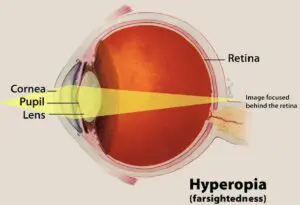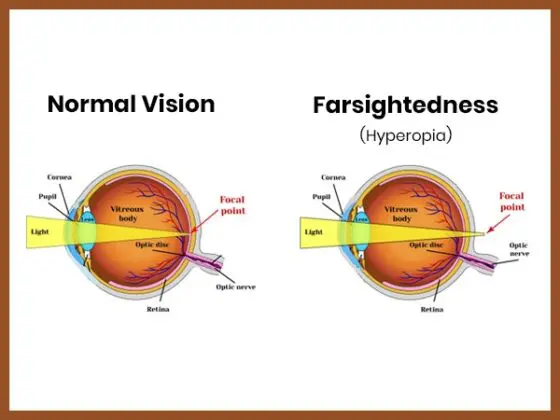If you have difficulty seeing objects that are close to you, you may be suffering from a common eye condition known as farsightedness (hyperopia). This can be a frustrating problem, but there are treatments available that can help. In this blog post, we will discuss what farsightedness hyperopia is, the symptoms to look for, and the various treatment options available. We hope that this information will help you get on the path to a better vision!
Contents
What Is Farsightedness Hyperopia?
 Farsightedness, or hyperopia, is a vision condition in which distant objects appear clear but close ones do not. It occurs when the eyeball is too short or the cornea has too little curvature. As a result, light entering the eye focuses beyond the retina instead of on it. This causes distant objects to look clear while close ones appear blurry.
Farsightedness, or hyperopia, is a vision condition in which distant objects appear clear but close ones do not. It occurs when the eyeball is too short or the cornea has too little curvature. As a result, light entering the eye focuses beyond the retina instead of on it. This causes distant objects to look clear while close ones appear blurry.
This condition is usually present at birth but may worsen with age. Hyperopia can also develop after an eye injury or due to certain diseases such as diabetes. There are two types of farsightedness: simple and compound.
Simple hyperopia occurs when the eyeball is shorter than normal or the cornea has too little curvature. It is the most common type of farsightedness. Compound hyperopia occurs when both the eyeball and cornea are misshapen. This type is less common.
If you are farsighted, there are various things that you can do to help this vision problem. So do not hesitate to see your eye doctor to help you out.
What Are The Symptoms?
There are a few different signs and symptoms of farsightedness, and they all have to do with your vision. If you’re farsighted, you may have trouble:
- Seeing objects up close
- Reading small print
- Distinguishing between different colors
- Driving at night
These symptoms can be mild or severe, depending on how farsighted you are. If your farsightedness is mild, you may not have any symptoms at all. Additionally, you might not notice any symptoms until you try to do something that requires good near vision, like reading small print.
What Are The Causes of Farsightedness Hyperopia?
There are a few possible causes of farsightedness, but the most common one is an eyeball that’s too short. This prevents light from focusing directly on the retina, which is the back part of your eye where images are sent to your brain. This cause is believed to be genetic.
Other possible causes include:
- A cornea that’s too flat
- A lens that’s not flexible enough
All of these factors cause light to focus behind the retina, resulting in blurred vision. Farsightedness is often first noticed in school-age children when they have difficulty seeing the blackboard or other objects at a close distance. If you have farsightedness, you may also experience headaches, eyestrain, and fatigue.
With these causes, certain risk factors can increase the likelihood of developing farsightedness. These include:
- A family history of farsightedness
- Premature birth
- Certain health conditions, such as diabetes or high blood pressure
If you have any of these risk factors, be sure to tell your eye doctor so they can keep an eye on your vision and make sure you’re getting the best possible treatment.
Is Hyperopia Farsightedness Or Nearsightedness?
 This is a common question. The answer is that it is both. It all depends on how much of a refractive error you have and whether your cornea or lens can compensate for it.
This is a common question. The answer is that it is both. It all depends on how much of a refractive error you have and whether your cornea or lens can compensate for it.
If you are only slightly farsighted, your eyes may be able to focus the light properly without corrective lenses. But if you are moderately or severely farsighted, light focuses behind your retina instead of on it. This is because your eyeball may be too short or your cornea may not curve enough. As a result, you may have difficulty seeing objects up close.
More often farsightedness hyperopia can be corrected with contact lenses or eyeglasses. For those with a severe refractive error, surgery may be necessary to improve vision. This can involve correcting the shape of your cornea or implanting a lens inside your eye.
If you have any questions about farsightedness or other vision problems, please make an appointment with a professional as they can provide you with the best information and care.
How To Diagnose It?
The diagnosis of farsightedness is usually made during a routine eye examination. Your doctor will ask you to read an eye chart, which measures how well you see at various distances. Some types of tests can be done to specifically measure farsightedness. These include:
- Retinoscopy: This test is usually done during a routine eye examination. The doctor will shine a light into your eye and then look at the reflection off the back of your eye. He or she can then determine the power of the lens that is needed to correct your vision.
- Autorefraction: In this, the doctor will place you in front of a machine that shines light into your eyes and then measures how the light is reflected back. This information is used to calculate the power of the lens that is needed to correct your vision.
- Refraction: This is the most common test used to measure farsightedness. The doctor will place you in front of an eye chart and ask you to read the letters at different distances. He or she will then use a machine called a phoropter to determine which lens power gives you the best vision.
These tests can help your doctor determine if you have farsightedness and how severe it is. If you have mild farsightedness, you may not need treatment. But if you have moderate or severe farsightedness, you may need to wear corrective lenses or have refractive surgery.
What Treatments Can Help With Farsightedness Hyperopia?
 There are several different treatments available for farsightedness, depending on the severity of the condition. These are divided into two types of treatment options, these include:
There are several different treatments available for farsightedness, depending on the severity of the condition. These are divided into two types of treatment options, these include:
For mild cases
There are two common treatments for mild farsightedness: eye exercises and vision therapy.
Eye exercises are designed to strengthen the eye muscles and improve focusing ability. You can try some simple eye exercises at home, such as rolling your eyes in different directions or blinking rapidly for a minute.
Vision therapy is another treatment option for mild farsightedness. It typically involves a series of activities and exercises that are performed under the supervision of an eye doctor or therapist.
Both of these treatment options are typically done under the guidance of an eye doctor or therapist. However, it’s best to consult an eye doctor before starting any type of exercise regimen.
For more severe cases
Glasses, contact lenses, or refractive surgery may be needed to correct your vision in severe cases.
Glasses and contact lenses are perhaps the most common treatment for farsightedness. They work by bending the light that comes into your eyes, which then helps to focus the image on your retina. This can help to improve your vision and make things appear clearer.
Refractive surgery is another option that can be considered for treating farsightedness. This type of surgery works by changing the shape of your cornea, which is the clear front part of your eye. Doing this helps to refocus the light that enters your eye and can improve your vision.
So overall, there are a few different options that can be considered. If you think that you may be suffering from this condition, then it’s important to see an eye doctor so that they can help to diagnose and treat the problem.
Conclusion
To conclude, farsightedness hyperopia is a common refractive error where distant objects appear clearer than those up close. It occurs when the eyeball is too short or the cornea has too little curvature. If you think you may be suffering from this condition, be sure to see your doctor or an optometrist for a proper diagnosis.
There are several effective treatments available, so don’t hesitate to get the help you need!
For more information and guidance, please contact Eye Mantra. EyeMantra offers the most advanced eye surgery options including PRK, Femto Lasik, SMILE surgery, Standard lasik, and Contoura vision. If you have any questions on lasik surgery, lasik surgery cost and lasik procedure, call us at +91-9711116605 or email at [email protected].


